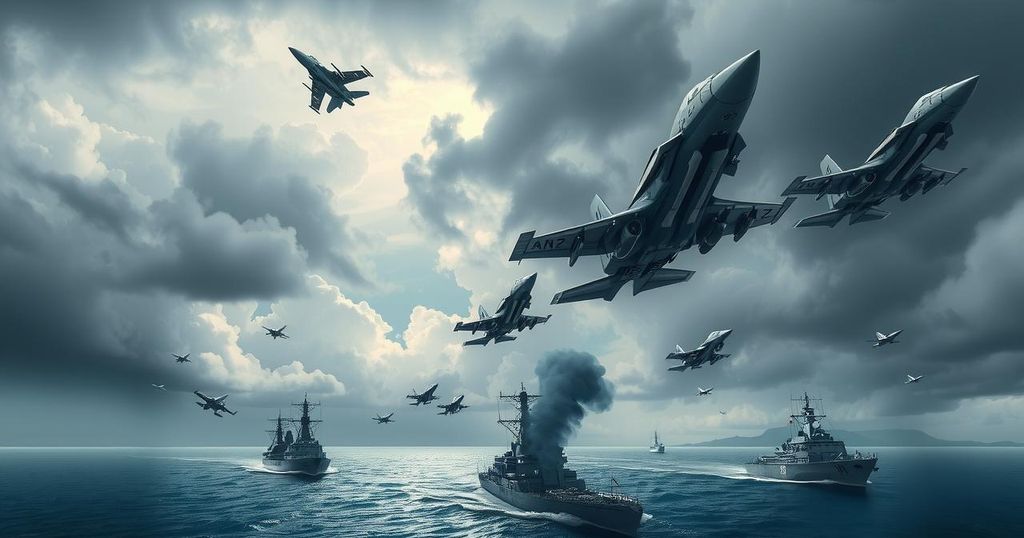Politics
AFP, ASIA, BEIJING, CHINA, DEFENCE MINISTRY, DEFENSE, EAST CHINA SEA, EASTERN THEATER COMMAND, FOREIGN MINISTRY, LAI, LAI CHING - TE, MEXICO, MILITARY, NORTH AMERICA, PEOPLE ’ S LIBERATION ARMY, PINGTAN, SHANDONG, SHI YI, TAIPEI, TAIWAN, TAIWAN STRAIT, TERRITORIAL DISPUTES, UNITED STATES, US STATE DEPARTMENT, US-CHINA RELATIONS, WASHINGTON
Clara Montgomery
China Concludes Military Drills, Heightening Tensions with Taiwan
China concluded a two-day military drill simulating strikes against Taiwan, which drew condemnation from Taiwan and criticism from the United States. Named “Strait Thunder-2025A,” the exercises tested the Chinese military’s capabilities and were conducted amid increasing tensions following Taiwanese leader Lai’s remarks about China. With regional security at stake, the U.S. emphasized its commitment to Taiwan’s defense amidst escalating military provocations from Beijing.
On Wednesday, China announced the conclusion of two days of military drills, which incorporated “live-fire” exercises and simulated attacks targeting critical ports and energy sites relevant to Taiwan. These unexpected maneuvers drew condemnation from Taiwan, and the United States labeled them as “intimidation tactics,” arriving shortly after Taiwanese President Lai Ching-te characterized China as a “foreign hostile force.”
The exercise, named “Strait Thunder-2025A,” prominently took place in the middle and southern regions of the Taiwan Strait, along with segments of the East China Sea. A spokesperson for the People’s Liberation Army, Shi Yi, stated the Eastern Theater Command had successfully executed all intended tasks during the exercises planned for April 1 and 2.
The military confirmed it had engaged in “long-range live-fire drills” intended to reinforce its capacity for precise strikes on selected targets within the area. Journalists from AFP reported observing fighter jets circling the Pingtan island, the closest location on the mainland to Taiwan, where a military base is situated. Notably, the Chinese aircraft carrier Shandong participated in the drills focused on testing potential blockade tactics against Taiwan.
On Wednesday, China’s foreign ministry issued a warning stating that punitive actions against Taiwan would continue until the island’s leaders cease their push towards independence. The ongoing tensions surrounding the democratic entity of 23 million are underscored by its relationship with the United States, which stands as Taiwan’s primary security ally.
The US State Department criticized China’s assertive military maneuvers and rhetoric towards Taiwan, emphasizing that such actions heighten regional tensions and jeopardize global security. Chinese leadership has condemned American support for Taiwan, particularly targeting Lai, whom they refer to as a “separatist.”
Following these military exercises, which occurred just one day after China mobilized its army, navy, air force, and rocket units around Taiwan, Taipei also heightened its military readiness. Taiwan’s defense ministry clarified that no live-fire exercises occurred in the vicinity on Wednesday while detecting 36 Chinese aircraft, 21 warships, and 10 coast guard vessels operating around the island.
On the previous day, the counts were notably higher, with 21 warships, 71 aircraft, and 4 coast guard boats reported. Amidst these developments, China’s Eastern Theater Command utilized social media to propagate a message titled “Paralysing Strikes,” which illustrated Chinese forces surrounding Taiwan and launching missile assaults.
Chinese Ministry of Defence spokesperson Zhang Xiaogang reiterated that pursuing independence would lead Taiwan to a “state of misery.” In contrast, Major General Meng Xiangqing cautioned that further military exercises could follow soon if Taiwanese separatists overstepped designated boundaries.
In recent years, Beijing has significantly increased military pressure on Taiwan, conducting numerous substantial drills around the island, commonly interpreted as preparations for a potential blockade. Tensions have especially intensified since Lai’s inauguration in May 2024, as he adopted a firmer stance on the island’s sovereignty compared to his predecessor, Tsai Ing-wen.
While Taiwan regards itself as an independent entity, most countries, including the United States, refrain from recognizing its statehood, favoring diplomatic relations with China. In a previous address, Lai denounced China as a “foreign hostile force” and proposed 17 measures aimed at counteracting burgeoning Chinese espionage and influence in Taiwan.
During a recent visit to the region, US Defense Secretary Pete Hegseth pledged to maintain a “robust, ready, and credible deterrence” in the Taiwan Strait. Taiwanese analyst Wen-Ti Sung suggested that China is employing recurrent military exercises to assess the extent of US support for Taiwan and other regional allies. Amanda Hsiao of the Eurasia Group noted that China aims to portray Lai as the provocateur in order to influence Washington’s perspective regarding Taiwan.
Despite the United States being legally bound to supply arms to Taiwan, it has consistently upheld a policy of “strategic ambiguity” concerning military intervention in defense of the island against a potential Chinese assault. A senior Taiwanese security official highlighted that the recent military drills were also intended to keep troops active to prevent unrest and speculation following personnel changes within China’s military.
In summary, China’s recent military drills targeting Taiwan serve as a stark reminder of rising tensions in the Taiwan Strait. The military exercises, condemned by both Taiwan and the United States, indicate Beijing’s ongoing pressure on Taiwan, particularly in light of Taiwan’s leadership’s pro-sovereignty stance. The geopolitical implications of these drills are profound, suggesting potential shifts in US support and increasing tensions within the region. As such, both local and international stakeholders will be closely monitoring future developments regarding cross-strait relations.
Original Source: www.wfxg.com






Post Comment